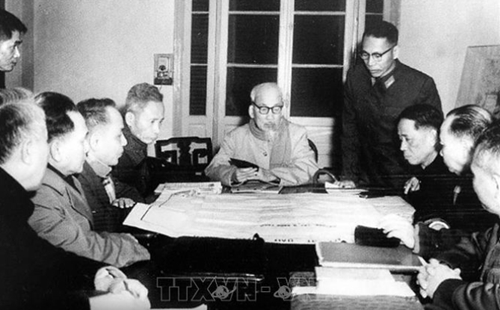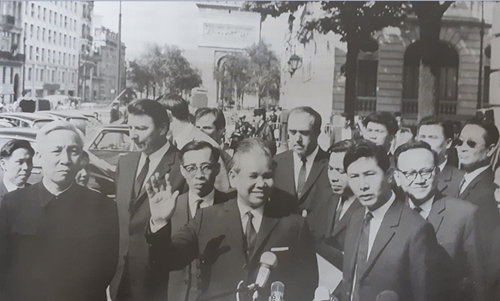The General Offensive and Uprising in Spring 1968 forced the U.S. to stop bombing the North and start negotiation with the attendance of representatives of the National Liberation Front of South Vietnam. This was the victory at first with strategic importance.
A breakthrough
The General Offensive and Uprising in Spring 1968 gave the U.S. a great blow, bringing a deep change in the U.S. invasion in Vietnam while disheartening the enemy’s spirit, forcing the U.S. to join negotiation.
    |
 |
|
The Politburo's meeting on December 28, 1967 gives the decision on the launch of the Spring 1968 General Offensive and Uprising. (Photo: VNA) |
“The U.S. was aware that Vietnamese people could not be defeated by war. The only way for them was to negotiate. Therefore, the enemy was forced to negotiate with Vietnam at the Paris Conference. The Vietnamese side would like to open a new battlefield on diplomacy via the conference. We also knew that at the negotiating table, we could not get what we could not get on the battlefield,” according to reporter Ha Dang, a former member of the negotiation delegation of the National Liberation Front of South Vietnam at the Paris Conference.
The negotiation which forced the U.S. to stop bombing the North was the first victory of Vietnam with strategic significance. Vietnam wanted to negotiate with the participation of four sides so as to promote the role of the National Liberation Front of South Vietnam. On the other hand, the U.S. tried its best to lower the importance of the National Liberation Front of South Vietnam. The U.S. only participated in negotiations on military issues directly related to the U.S., while other issues, including the government in South Vietnam, should be handled by “Vietnamese side.”
Besides, where to negotiate was also a big problem. “Vietnam suggested Phnom Penh, but the U.S. did not accept it because Cambodia’s capital was close to the Vietnam battlefield, it would be greatly affected. We then made proposal to organize negotiations in Warsaw (Poland) but it was also rejected by the U.S. Meanwhile, we also disagreed to the U.S. recommendations such as Geneva (Switzerland), and Katmandu (Nepal). Finally, we chose Paris (France) and the U.S. then accepted,” said Ambassador, Prof., Dr. and former Director of the Diplomatic Academy Vu Duong Huan.
According to Professor Vu Duong Huan, we intentionally decided to run negotiations in Paris. Paris was the capital of a big country, not only in Europe, but in the whole world, a global media center. Therefore, a news or an information broadcast from Paris would be expanded to the whole world. Furthermore, in Paris, there was a movement of the French people who loved peace and justice and supported the Vietnamese resistance war against the U.S. invaders, especially the French Communist Party. Meanwhile, at that time, the French government led by President De Gaulle who also did not completely support the U.S.
On September 1, 1966, in his speech before 100,000 people in Phnom Penh, Cambodia, President De Gaulle publicly denounced the U.S. policy in Vietnam and called on the government to withdraw its troops from the Southeast Asia. In particular, in France, there was a large number of overseas Vietnamese, built by Uncle Ho himself during his time in France. Geographically, it was not difficult to take a flight from Hanoi to Beijing (China) or Moscow (USSR) then take a train to Paris. In addition, in Paris, we had an opportunity to go to dozens of nearby countries to call for the support of international friends.
The person who made recommendations to negotiate in Paris was Vo Van Sung, Representative General of the Government of the Democratic Republic of Vietnam in France. “Choosing where to negotiate was also a diplomatic art of Vietnam. We offered many locations, but were not accepted by the U.S. We proposed the final place and the enemy could not refuse. It was also a form of time wasting for both sides,” said Professor Vu Duong Huan.
Although the conference included four sides, but the Democratic Republic of Vietnam did not recognize the Republic of Vietnam, while the U.S. vetoed the National Liberation Front of South Vietnam. This issue raised a question on the shape of the negotiating table. Some suggested that it could be square, rectangle, oval or round.
It took them two months for the “battle of the tables.” Accordingly, after numerous iterations of proposals and rejections, the Soviet Union proposed a giant, round table with two smaller rectangular tables located at two opposite sides of the round table. Everyone agreed. The host country finished making the furniture in one night.
    |
 |
|
Head of the delegation of the Democratic Republic of Vietnam Xuan Thuy (center, front line) and special advisor Le Duc Tho (left, front line) (An archived photo) |
The U.S.’s cheat
During nearly five years of negotiations in Paris, the U.S. cheated many times in order to delay or break the agreement. Especially, in mid-December 1972, the U.S. accused Vietnam of prolonging negotiations, the U.S. conducted the strategic air raids using B-52 Stratofortress in Hanoi, Hai Phong, and some Northern localities (Operation Linebacker II or Christmas Bombing).
“The U.S. bombing of the North in December 1972 was a ploy,” emphasized Professor Vu Duong Huan. At first, the enemy put pressure on Vietnam to amend 63 articles of the agreement at the request of the Saigon government. The Richard Nixon administration also wanted to prove to Nguyen Van Thieu that the U.S. tried to do its best to protect its allies, instead of withdrawing without fighting.
In a letter written on November 14, 1972 to Nguyen Van Thieu, President Nixon wrote, “I absolutely pledge to you that if Hanoi does not comply with the conditions of this agreement, I will resolutely take action quickly and fiercely.”
The U.S. used B-52s to drop more than 36,000 tons of bombs on Hanoi, Hai Phong and some localities in North Vietnam to destroy military-economic facilities while preventing the North’s aid to the South. Previously, the U.S. devastated the capital of the Democratic People’s Republic of Korea, Pyongyang, before losing.
Operation Linebacker II also showed the strength of the U.S. diplomacy. On November 13, 1972, when meeting with special advisor Le Duc Tho, Henry Kissinger read Nixon’s telegram which threatened to stop negotiations and resume bombing. However, Mr. Le Duc Tho affirmatively replied, “Threatening us has no use! We have been fighting with you (the U.S.) for ten years and have been negotiating for five years. Now are you ready to go to the solution, you can't use threats against us.”
“It can be said that the U.S.’s defeat in Hanoi paved the way for us to force the U.S. to sign the Paris Peace Accords on January 27, 1973,” Prof., Dr. Vu Duong Huan concluded.
Translated by Minh Anh